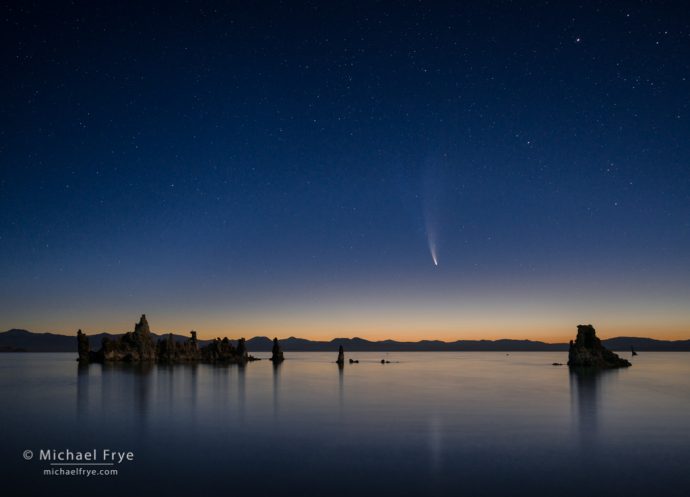Early this morning Claudia and I joined about a dozen other photographers along the shore of Mono Lake to photograph Comet NEOWISE.
I was expecting to search for a smudge in the sky to the northeast, and use a long lens to make the comet a prominent part of the photograph. But when I stepped out of the car I could see it right away – even before my eyes adjusted to the dark. It was bigger than I expected. It’s the brightest, largest comet I’ve seen since Hale-Bopp in 1997.
We moved down to the lakeshore and looked for ways to juxtapose the comet with some of Mono Lake’s iconic tufa formations. At first I looked for telephoto compositions, as a long lens lens would have filled up more of the frame with the comet. But then I found this wider view, and liked the balance and feeling of it, with the comet perched above a row of tufa towers.
Photography aside, the comet was a beautiful sight, hanging tail-up over the lake in the predawn sky.
Over the next few days the comet will become lower and less visible in the morning, but higher and more visible in the evening to the northwest. It’s also expected to get gradually dimmer over the next few weeks as it moves farther from the sun, so the next week or so might be the best time to see it. This page has good descriptions of where and when to view the comet.
— Michael Frye
Related Posts: Starry Skies Adventure Workshop; Lightning at Mono Lake
Michael Frye is a professional photographer specializing in landscapes and nature. He is the author or principal photographer of The Photographer’s Guide to Yosemite, Yosemite Meditations, Yosemite Meditations for Women, Yosemite Meditations for Adventurers, and Digital Landscape Photography: In the Footsteps of Ansel Adams and the Great Masters. He has also written three eBooks: Light & Land: Landscapes in the Digital Darkroom, Exposure for Outdoor Photography, and Landscapes in Lightroom: The Essential Step-by-Step Guide. Michael has written numerous magazine articles on the art and technique of photography, and his images have been published in over thirty countries around the world. Michael has lived either in or near Yosemite National Park since 1983, currently residing just outside the park in Mariposa, California.










Greatr image, Michael! Mono Lake is a fabulous place to photograph the comet. No such luck around here (Washington, DC region) but I have a few days to try and locate a spot for the evening. Thanks for the link on how to see it. It’s better than any I have found so far.
Regards,
Robin
Thanks Robin! Hope you had some luck.
This is simply awesome. Thanks for sharing the photo!
Great capture Michael. You must have been excited. Hope you’re well and hi to Claudia.
Thank you Kathy, and yes, it was fun!
Thanks Gina!
Wonderful shot, Michael. Thanks for sharing your story and photo (and the link).
Thank you CK!
Hi
Would the comet still be visible from Mono Lake this week (7/19-7/23)?
The comet has become dimmer. It’s also lower in the sky to the northeast in the morning – too low – while higher in the sky to the northwest in the evening. So you won’t get this view, which was looking northeast in the morning, but you could see the comet to the northwest in the evening from a different spot – somewhere without high mountains blocking the view.
Since the comet has become dimmer, it has to get quite dark before you can see it or photograph it. That means it’s essentially a night shot, so you’ll need a wide aperture, high ISO, and relatively short exposure times so that the stars and comet don’t turn into streaks.